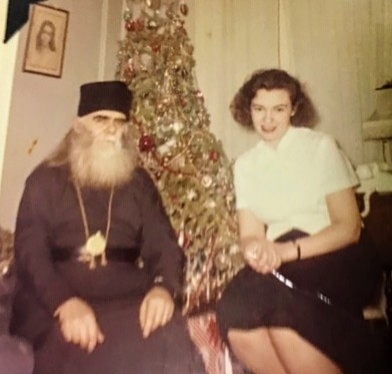A few weeks ago we published a post by Amber Schley Iragui about an iconographer, Heather MacKean, who turned out to be her church sponsor. That made us start asking around about other women and their godmothers. Here's what a Woman of the Week from earlier this year, Nadia Kizenko, had to say about hers. In the photo below, you see Nadia (left), with Irina (center), and her own mother.
Godparent choices can be prophetic. My godmother, Irina Itina, was my parents’ neighbor in the Bronx, one of the few godparents they picked who was not related to either of them. That act introduced me to the notion that one could choose company not out of blood, but out of affinity.
As the years went by, my godmother’s influence cast a long, forward-pointing shadow. I did not see her as often as I would have hoped, because when I was forty days old my parents moved from the Bronx to Syracuse, New York. Irina then moved to Yonkers, where she lived with her widowed mother. From there she commuted to her job in the Economics division of the New York Public Library. She worked there till her retirement, when she turned those professional services to volunteering in the library of St. Vladimir’s Seminary.
Irina showed me that not everyone was married with kids. Instead, she sent me postcards from her European travels—Brussels, Switzerland. She also sent both my sister Irina (her namesake and only one year younger than I) presents at Christmas and Easter, and remembered me separately and specially on my birthday and namesday. On one of the few times we visited her, the drive past Manhattan and the Life magazine in her house with daring photographs by Rudi Gernreich also carried whiffs of another world. In her distance, her generosity, her height (close to that of my father), and her elegance, the glam fairy godmother in Cinderella looked more than a little like her. Her cards written in spidery old orthography Russian were one of the reasons I decided to follow my father (and Likhachev and Nabokov) and started to try to use old orthography as well.
Irina was also not like other friends of my parents in having a distinct spiritual trajectory. She was born in Serbia, not the former Soviet Union. She therefore carried a whiff of interwar Europe, which compared to the dekulakization, famine, and purges of my parents’ families seemed the height of safety and stability. That may have been what gave her a certain spiritual independence. From close friendship with Archbishop Averky (Taushev) (see photo) and real devotion to Bishop (later Saint) John Maximovich of San Francisco, she gradually moved from the Russian Orthodox Church Outside of Russia to the Orthodox Church of America, partly because of the rough treatment she thought St. John received from 75 East 93rd Street, and partly because of the intellectual satisfaction she received from attending lectures by priests like John Meyendorff, Thomas Hopko, and Paul Lazar. When my worried father asked, “What have you lost?”, she smiled, and they stayed friends till he died. This was another valuable lesson: those you entrust with your children’s spiritual growth can change jurisdictions (and in the 1970s ROCOR that really meant something), but it does not mean the appreciation or the relationship need be over.

When I graduated from Harvard and went abroad on a Rockefeller Fellowship, my own travels began. Now it was me sending her letters with foreign stamps or postcards of Lake Geneva. When our paths occasionally crossed, whether at some wedding, funeral, or even canonization, she would tell me about how much she enjoyed helping St. Vladimir’s with its cataloging. She got particularly animated in describing what a challenge it was cataloging perestroika-era reprints of pre-revolutionary editions: how did one convey that it was a reprint, but a later one? Through her, I started to understand what it meant to have a logical, systematic mind so different from mine.
What really brought us close, however, was when my first marriage started to collapse. My mother, seeing that I was near despair, said, “Why don’t you try calling your godmother?” I said glumly, “I don’t know. As far as I know she has never been in a relationship—and she seems such a good, pure person. What can she possibly say to me about a mess like this?”
As it happened, a lot. For the first time, we started to speak on a regular basis. She helped me to understand that “let the man be the head of the woman” did not mean that he had a right to raise a hand to her, or hit with words as well as blows. She was not the only person who helped me at that ghastly time, but her moral authority carried especially strong weight. If I came through it, it is thanks in large measure to her. In the years before and since, I have not always lived up to the high example she set. But she helped me take paths in Orthodox life and culture that might very well have eluded me otherwise.
Nadieszda (Nadia) Kizenko studies different aspects of Orthodox Christianity, including liturgy and cultural reflection, in the Russian empire and its Slavic-language successor states. She is a professor in the History Department at the State University of New York at Albany. Her latest book has a prepublication title of Confess All, Forgetting Nothing: Church, State, Society, and the Sacrament of Confession in the Russian Empire from the 17th Century to 1917.


